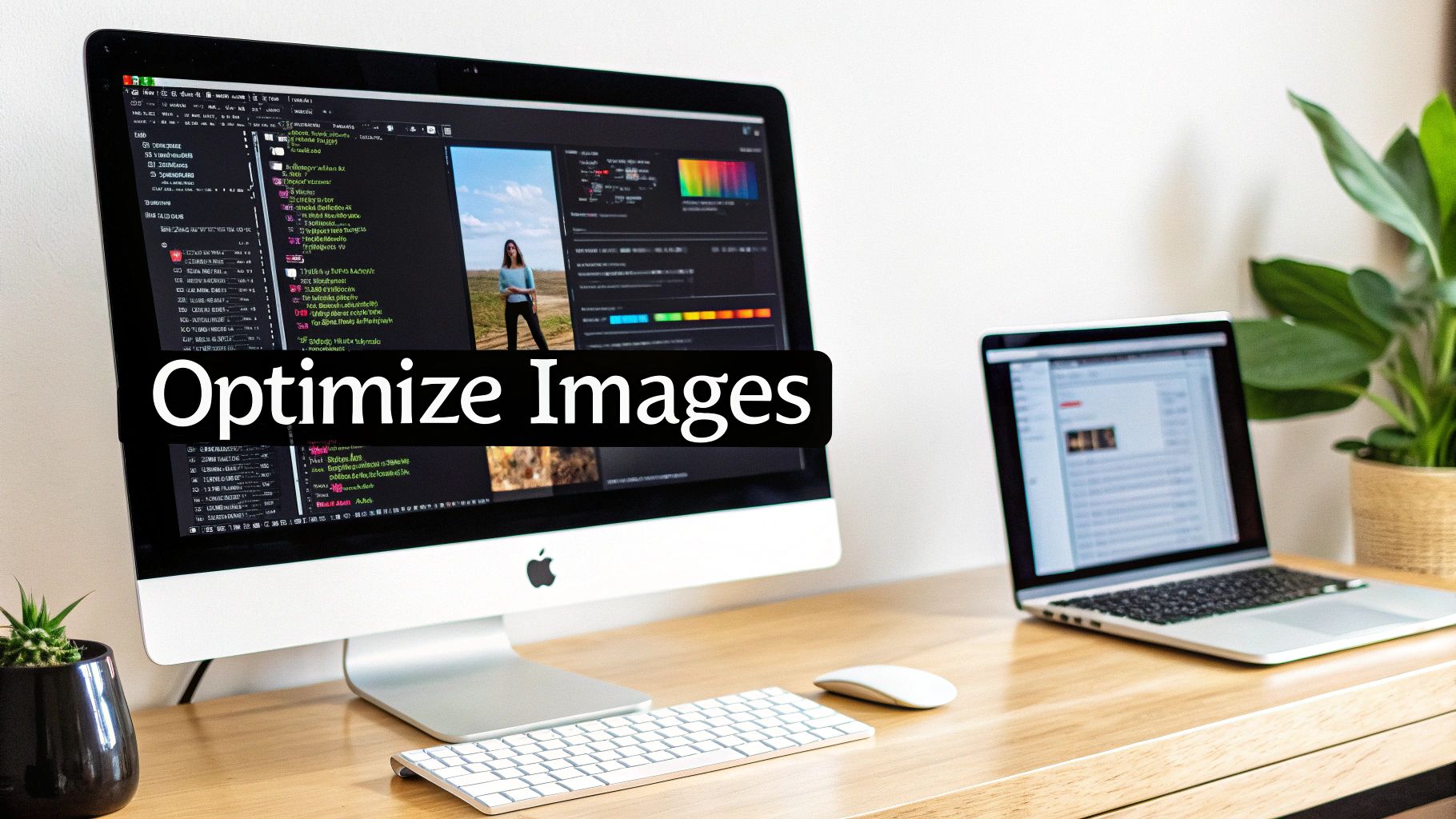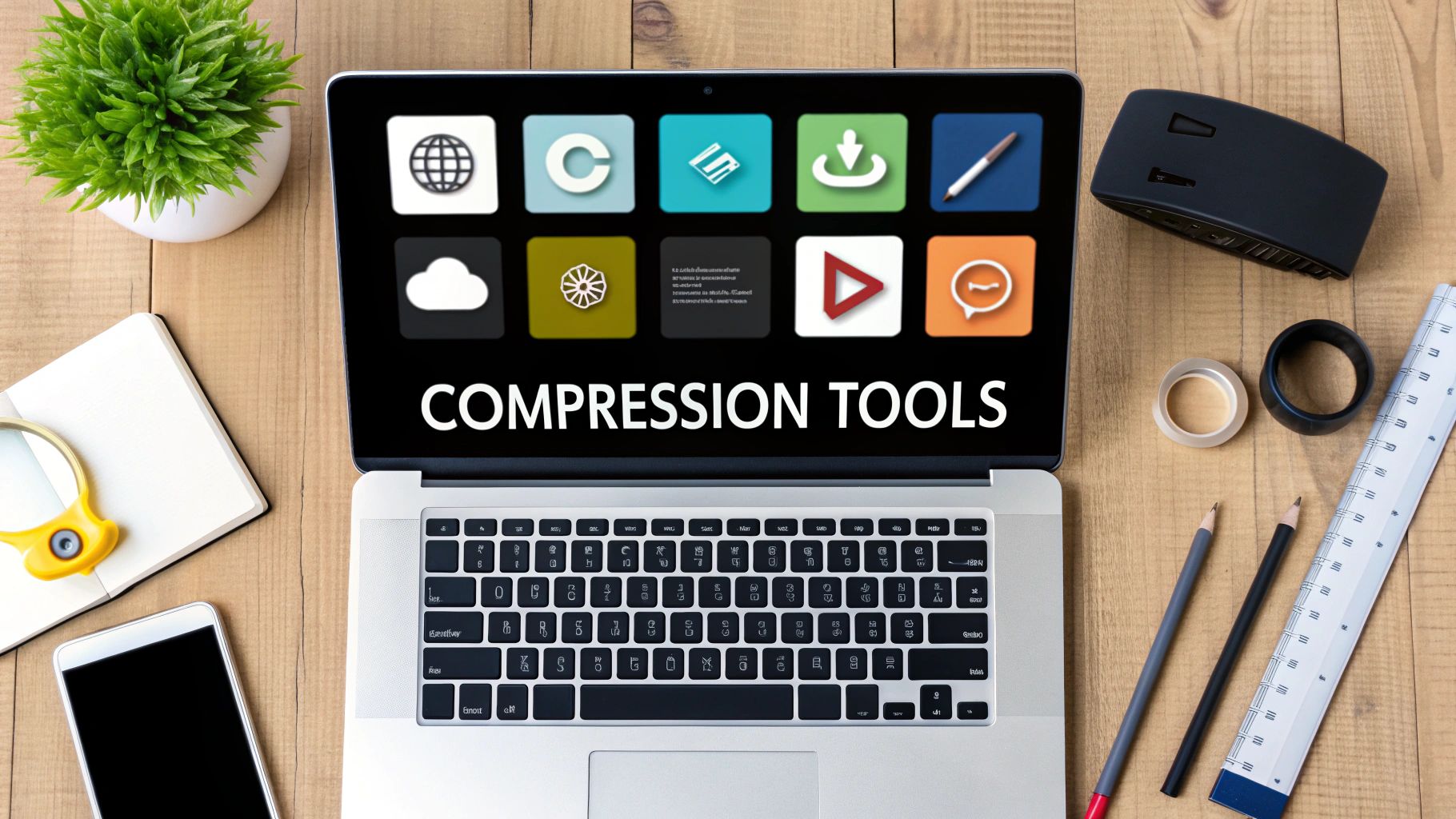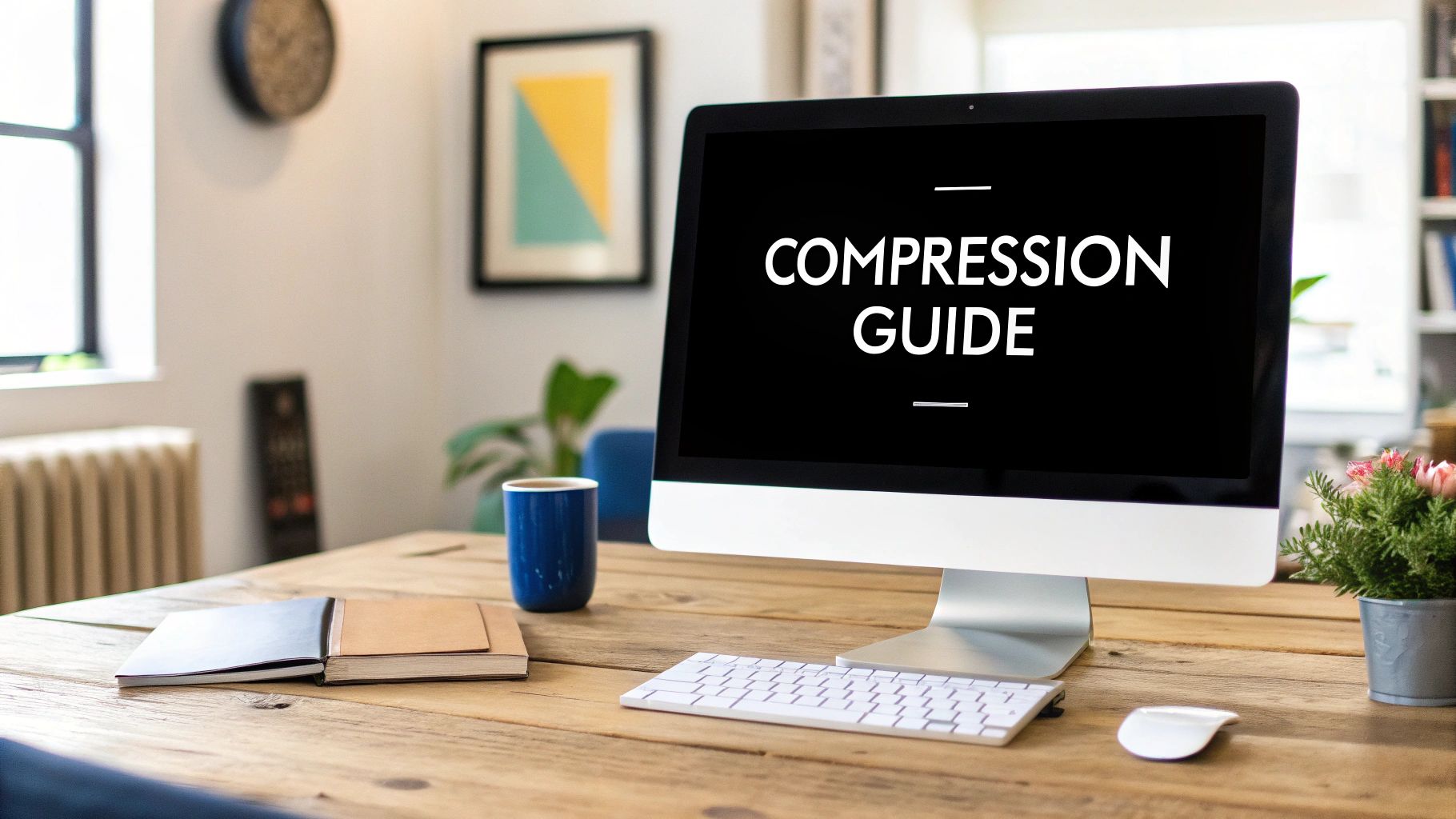Speed up website by compressing images: Boost Performance
The Critical Connection: Image Size and Site Performance

Large images are a common cause of slow websites. Think of your site like a highway. Smaller, compressed images are like cars, zipping along quickly. Uncompressed images are like large trucks, slowing everything down. This poor performance impacts user experience.
Visitors may leave your site before it even loads, costing you conversions and revenue.
The Domino Effect of Slow Images
Slow images frustrate users. Studies show that almost 40% of visitors will abandon a site that takes more than three seconds to load. This impacts key metrics like conversion and bounce rates. Search engines like Google also favor fast sites, potentially lowering rankings for slower ones. Image size directly affects visibility and profitability.
Image compression significantly reduces file size without sacrificing quality. Research suggests compression can shrink images by over 70%, reducing the data needed for page rendering. One user of the Tinify tool reported a 70% reduction, leading to much faster load times.
This not only speeds up page loading, but also reduces bandwidth use and server load, particularly important for high-traffic websites. Studies show top-ranking Google sites average a load time of just 1.65 seconds.
Compressing images improves user retention and conversion rates. It also boosts SEO rankings, as search engines prioritize fast sites. This makes image compression essential for digital marketers. Tools like Tinify and CDNs that automatically compress images are widely used to maintain website performance. Explore this further here.
Mobile Matters: The Impact of Connection Types
Image size is even more crucial on mobile, particularly with slower connections. Optimizing images is key, and another strong strategy is using multimedia, like video production. Imagine downloading a large image on a 3G connection; the wait can be unbearable. Slow loading leads to frustration and site abandonment.
This emphasizes the importance of mobile image optimization, including considering varying screen sizes and resolutions. By compressing images, you ensure accessibility and enjoyment for all users, regardless of device or connection. This positive user experience is crucial for engagement, conversions, and website success.
Image Compression Arsenal: Tools That Actually Deliver

We've talked about why compressing images is so important for website speed. Now, let's get practical and explore the tools that make it happen. Picking the right tool is key to finding the sweet spot between quality and file size. This section will guide you through the available options and help you choose the best one for your needs.
Lossy vs. Lossless: Choosing The Right Approach
First, it's important to understand the difference between lossy and lossless compression. Imagine lossy compression as pruning a tree. You remove some branches (data) to make it smaller, but the overall shape stays the same. Lossless compression, on the other hand, is like folding clothes – you make them smaller without removing anything.
Lossy compression shrinks files more dramatically but can slightly reduce image quality. Lossless compression preserves all the image data but results in less significant size reduction.
For images where pristine quality is essential, like professional photography, lossless compression is the safer bet. For most web graphics, however, lossy compression offers an excellent balance.
Tools For Every Workflow
There are numerous image compression tools available, each designed for different workflows. Some are standalone apps, while others integrate seamlessly into existing processes.
-
Standalone Tools: These dedicated apps provide a focused interface for image compression. Compresto, ImageOptim, and ShortPixel are good examples. They often give you detailed control over compression settings and allow batch processing.
-
WordPress Plugins: If you use WordPress, plugins like Smush, EWWW Image Optimizer, and Optimole automate image compression when you upload images. This significantly simplifies the optimization process.
-
Design Software Integrations: Design software like Photoshop and Affinity Photo often have built-in compression features. This lets you optimize images directly within your design workflow.
-
Automated APIs: Developers can integrate compression APIs into their websites and applications to optimize images automatically.
To help you choose the right tool, we've compiled a comparison table showcasing the strengths of each option.
To help you choose the right tool, we've compiled a comparison of popular options:
Comparison of Elite Image Compression Tools This table compares key features, compression rates, supported formats, and pricing options across the most popular image compression tools.
| Tool Name | Compression Rate | Supported Formats | Batch Processing | Automation Options | Free/Paid | Best For |
|---|---|---|---|---|---|---|
| Compresto | High | JPG, PNG, SVG, GIF | Yes | API | Paid | Developers, Businesses |
| ImageOptim | Medium | JPG, PNG, GIF | Yes | CLI | Free | Mac users |
| ShortPixel | High | JPG, PNG, GIF, PDF | Yes | API, plugins | Paid | Websites, Photographers |
| Smush | Medium | JPG, PNG, GIF | Yes | WordPress plugin | Free/Paid | WordPress users |
| EWWW Image Optimizer | Medium | JPG, PNG, GIF | Yes | WordPress plugin | Free/Paid | WordPress users |
| Optimole | High | JPG, PNG, WebP | Yes | WordPress plugin | Paid | WordPress users |
| Photoshop | Medium | JPG, PNG, GIF, TIFF | Yes | Actions | Paid | Designers |
| Affinity Photo | Medium | JPG, PNG, GIF, TIFF | Yes | Macros | Paid | Designers |
This table gives a quick overview of several image compression options. The "Best For" column highlights the ideal use case for each tool, helping you find the perfect fit for your needs.
Finding The Perfect Fit
The best tool for you depends on how you work and your technical skills. If you're comfortable with manual adjustments and batch processing, a standalone tool or design software integration might be ideal. If you prefer automation and simplicity, especially for a content-heavy website, a WordPress plugin could be a better choice. Developers seeking more flexibility and scalability should consider integrating APIs. For additional tips, check out our guide on file size reduction tips.
Fine-Tuning For Optimal Results
No matter which tool you choose, it's important to experiment with different compression levels and settings to find the right balance between file size and image quality. For instance, JPEGs often handle higher compression without visible quality loss, while PNGs might require a lighter touch. Check out this resource on how to master image optimization for mobile. Testing various options and carefully reviewing the results is key to maximizing speed improvements while maintaining visual appeal.
Measuring Success: Quantifying Image Compression Impact

So, you’ve compressed your images. Excellent! But how can you be sure it’s actually improving your website's performance? That’s where measuring the impact comes in. We'll move beyond vague notions of "faster websites" and explore practical ways to track the real benefits of image compression. Let's see how your optimization efforts are paying off.
Establishing a Performance Baseline
Before you can measure improvement, you need a starting point. Think of it as a snapshot of your website's current performance – your baseline measurement. Tools like WebPageTest, Lighthouse, and GTmetrix offer detailed performance reports, providing key insights into load times and potential bottlenecks. These reports are crucial for understanding where you stand before making any changes.
For instance, WebPageTest lets you test your website’s load time from different global locations and on various devices, simulating real user experiences. Lighthouse, built into Chrome DevTools, gives you an in-depth audit focusing on performance, accessibility, best practices, and SEO. GTmetrix offers a similar analysis, providing recommendations to improve your site’s loading speed.
Key Metrics to Track
While total page size is important, it doesn't tell the whole story about image performance. Focus on specific metrics that reflect how images impact the user experience. Largest Contentful Paint (LCP), for example, measures how long it takes for the largest image or text block to become visible. Improvements to LCP directly translate to a better user experience, especially on image-heavy webpages.
Speed Index (SI) provides a broader perspective on how quickly content appears visually. This metric helps you gauge the perceived speed of your site. A lower SI means a faster-loading page. Consider using online tools like Compressx, which focuses specifically on image compression, when choosing a compression tool.
Interpreting Waterfall Charts
Waterfall charts, available in performance testing tools, provide a visual breakdown of how each element on your page loads. These charts help you pinpoint exactly how long each image takes to load and identify potential delays. You can then isolate the impact of image compression on the total page load time.
This granular view helps spot images that might still be causing bottlenecks, even after compression. Maybe a certain image format isn't ideal, or perhaps lazy loading could be implemented more effectively. Waterfall charts offer the clues needed to refine your optimization strategy.
Real-World Results and Expectations
So, what kind of real-world improvements can you expect from image compression? Quantitative tests reveal the concrete benefits. Studies show that image compression can improve load times by at least 10%, sometimes exceeding 24%, depending on the number of images and the optimization methods used. For example, compressing ten images on a single webpage led to a 10% average improvement in load time. Find more detailed statistics here.
More aggressive compression can push gains closer to 25%, demonstrating that image optimization is crucial for performance. This highlights that compressing images isn't just about aesthetics; it significantly affects loading speed, user engagement, and SEO. While 10% might seem small, combined with other optimizations like caching and GZIP compression, the impact is substantial. These improvements are readily achievable, especially for WordPress users who can automate image compression with plugins.
Beyond Basic Compression: Advanced Image Optimization

Compressing images is a crucial first step for faster websites. But to truly unlock peak performance, you need to go further. This section explores advanced techniques that can significantly boost your speed improvements and elevate your website's overall performance.
Responsive Images: Tailoring Images to Devices
Serving large images to mobile devices wastes bandwidth and slows down loading. Responsive images address this by delivering appropriately sized images to different devices. This eliminates unnecessary data transfer and drastically improves load times, especially on mobile connections.
Think of it like this: you wouldn't wear a winter coat in summer, right? Serving a large image to a small screen is similarly inefficient. Responsive images deliver the "right-sized image" for every device, ensuring a smooth user experience.
Technically, this is achieved using the HTML <picture> element and the srcset attribute. These allow the browser to select the most appropriate image source based on the user's screen size and resolution, optimizing both display and bandwidth usage.
Lazy Loading: Prioritizing Visible Content
Long webpages with numerous images can suffer from slow initial loading. Lazy loading solves this by delaying image loading until they are about to scroll into the user's view. This dramatically improves perceived performance by prioritizing the content users see first.
Imagine visiting a buffet. You wouldn't pile your plate with everything at once; you start with what you want first. Lazy loading works similarly, loading only the immediately visible images and fetching the rest as the user scrolls. This leads to a much faster initial page load and a better overall user experience.
You can implement lazy loading with JavaScript or by simply adding the loading="lazy" attribute to your <img> tags. This small change can have a big impact on perceived speed.
Next-Gen Formats: Embracing WebP and AVIF
While JPEG and PNG are common, formats like WebP and AVIF offer superior compression and often better quality. WebP typically produces smaller files than JPEG and PNG while maintaining comparable visual quality. AVIF goes even further, offering even smaller file sizes and often noticeable quality improvements, especially in images with complex textures or gradients.
Browser compatibility is a factor to consider. Using the <picture> element allows you to provide fallback options, ensuring that users with older browsers still see your images. This lets you take advantage of WebP and AVIF's efficiency while maintaining broad compatibility.
Content Delivery Networks (CDNs): Optimizing Global Delivery
For websites with a global audience, a Content Delivery Network (CDN) is crucial. CDNs distribute copies of your website's assets, including images, across servers worldwide. When a user accesses your site, the CDN serves these assets from the closest server, minimizing latency and boosting load times.
Imagine a business with multiple warehouses. It's faster and more efficient to ship from a warehouse near the customer than from a single central location. CDNs work similarly, delivering your images from the nearest server to optimize global delivery and create a consistent user experience no matter where your visitors are located.
These advanced techniques, combined with basic compression, form a powerful strategy to optimize image delivery and drastically improve website performance.
Speed Amplifiers: Beyond Basic Compression
The table below summarizes the techniques discussed, highlighting their potential impact on speed, implementation difficulty, and ideal use cases.
Speed Amplifiers: Beyond Basic Compression
| Technique | Potential Speed Improvement | Implementation Complexity | Browser Compatibility | Best Use Cases |
|---|---|---|---|---|
| Responsive Images | Significant | Moderate | Excellent | All websites, especially image-heavy sites |
| Lazy Loading | Significant | Low | Excellent | Long pages with many images |
| WebP | High | Moderate | Good (fallback required for older browsers) | Most website images |
| AVIF | Highest | Moderate | Growing (fallback required) | Images requiring high quality and small file sizes |
| CDN | Significant | Low (using a CDN provider) | Excellent | Websites with global audiences |
By implementing these strategies, you can deliver a faster, more efficient website that provides an exceptional user experience. For Webflow users, consider exploring this guide for optimizing site speed.
Global Impact: How Image Compression Transforms Experience
Beyond the technical details and metrics of image compression, let's explore how this practice affects user experience worldwide. It's not just about speed; it's about shaping how people perceive and interact with your content.
The Psychology of Waiting: Why Speed Matters
We expect websites to load instantly. Even small delays can frustrate users and lead to higher bounce rates and fewer conversions. This negative experience can harm your brand's reputation and erode user trust. A fast-loading site, however, builds confidence and encourages engagement.
A fast-loading site conveys professionalism and reliability, making users feel valued and respected. This creates a positive first impression and encourages them to explore your content further.
Global Connectivity: Adapting to Diverse Audiences
Internet speeds vary significantly around the world. Some areas have blazing-fast connections, while others rely on slower mobile networks. Your image compression strategy must account for this. Large, unoptimized images can make a website unusable in areas with limited bandwidth, excluding a portion of your potential audience. Efficient compression ensures accessibility for everyone, regardless of location or connection.
Page Weight and Load Times: The Data Speaks
Analyzing over 5 million web pages shows that page size dramatically impacts loading speed. Larger pages take 318% longer to load than smaller ones. Images often make up most of a page's size. Compressing them significantly reduces page weight, making pages load up to 486% faster. This greatly improves user experience, especially on mobile devices. For more details, check out these page speed stats. You might also find this interesting: How file compression reduces digital waste.
Case Studies: Global Brands Leading the Way
Leading brands like Airbnb and Pinterest, which rely heavily on visuals, invest in robust image compression. They recognize that fast-loading images are crucial for user satisfaction, engagement, and revenue. These companies understand that optimizing images directly contributes to a positive user experience and ultimately drives business growth.
The Financial Implications of Faster Images
Image compression benefits go beyond user experience; they directly impact your bottom line. Faster loading leads to more engagement, lower bounce rates, and higher conversions. This results in increased sales and revenue. In a competitive online market, milliseconds matter, and efficient image compression can give you a significant advantage. Even small improvements in loading times can noticeably affect key performance indicators (KPIs) and boost your business.
Automated Workflows: Set It and Forget It Compression
Manually compressing images is fine for a small website. But as your site expands and your image library grows, this manual approach becomes impractical. You need a way to optimize your website speed by compressing images automatically. This section explores practical automation strategies to maintain ongoing optimization without constant manual work.
CMS-Specific Solutions: Plugins for Easy Automation
Many popular Content Management Systems (CMSs) offer plugins to simplify image compression. For WordPress users, plugins like Smush, EWWW Image Optimizer, and Optimole handle compression seamlessly during the upload process. This eliminates the need for manual intervention, freeing up your valuable time. Similarly, platforms like Shopify and Drupal have their own image optimization plugins that automate this critical task. These plugins frequently provide different compression levels and customization options, allowing you to fine-tune the optimization for your specific requirements.
Developer Tools: Integrating Compression into Your Build Process
Development teams can achieve even greater control and efficiency by integrating image compression directly into their build process. Tools like Gulp and Webpack enable you to automate image optimization as part of your development workflow. This ensures every image deployed to your website is already compressed, minimizing the chance of missing files and maintaining consistent image quality. This is especially valuable for larger teams working on complex web projects.
CI/CD Pipelines: Automating Compression for Seamless Deployment
Taking automation further, integrating image compression into your Continuous Integration/Continuous Deployment (CI/CD) pipeline ensures optimized images with every code deployment. This "set it and forget it" method guarantees your website always uses the smallest possible image files, maximizing performance without any manual effort. Automating this process allows developers to concentrate on other critical tasks, boosting overall team efficiency. For further insights, check out this guide on How to Master Webflow Site Speed.
Establishing Image Policies and Training
Consistent image optimization relies on clear guidelines and team training. Create image policies outlining preferred file formats, compression levels, and naming conventions. Provide training materials for content creators and editors explaining why image optimization is important and how to adhere to these standards. This collaborative approach ensures everyone contributes to optimal website performance. A simple checklist for image uploads can remind content creators to optimize images before publishing.
Troubleshooting and Maintenance: Ensuring Long-Term Effectiveness
Even automated systems require occasional troubleshooting and maintenance. Regularly assess your website's performance using tools like WebPageTest and Lighthouse to identify potential image-related problems. Stay updated on plugin updates and adjust settings to maintain optimization effectiveness. This proactive approach prevents performance regressions and keeps your website running at its best. Addressing issues promptly sustains peak performance and avoids future complications.
Compresto offers a streamlined solution for your image compression needs. Try Compresto today and see how automated image compression can improve your website's performance. Visit Compresto